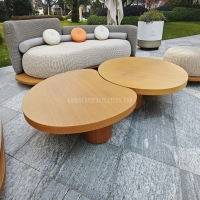Welcome to the website for landscape facilities products and knowledge.
How does the table’s design ensure it remains resistant to damage from frost or ice in winter?
As winter approaches, many homeowners and commercial establishments face the challenge of protecting their outdoor furniture from the damaging effects of frost and ice. The secret to maintaining table integrity throughout freezing conditions lies in sophisticated design principles and material science that work in harmony to combat winter's harsh elements.
Modern frost-resistant tables incorporate specialized materials engineered to withstand temperature extremes. High-density polyethylene (HDPE) and powder-coated aluminum lead the market in cold-weather performance, featuring closed-cell structures that prevent moisture absorption. Unlike traditional wood that expands and contracts with temperature changes, these advanced materials maintain dimensional stability even when temperatures plummet below freezing. The molecular composition of these materials includes UV stabilizers and anti-freeze additives that prevent cracking and structural degradation.
The structural design plays an equally crucial role in ice resistance. Manufacturers implement strategic water drainage systems through subtle sloping surfaces and concealed runoff channels. These design elements prevent water accumulation that could otherwise freeze and expand, causing surface damage or structural stress. Table legs and frames feature reinforced corner bracing and continuous welds that distribute stress evenly, eliminating weak points where ice could cause fractures.
Surface treatment technology represents another critical defense layer. Multi-stage powder coating processes create a seamless protective barrier that repels moisture while allowing minimal thermal conductivity. This coating system prevents ice from bonding strongly to the surface, reducing the risk of damage during ice removal. The non-porous nature of these finishes also inhibits frost from penetrating the material substrate.
Engineering considerations extend to the microscopic level, where material expansion coefficients are carefully calculated. Tables designed for cold climates utilize materials with matching thermal expansion rates across all components, preventing stress fractures when different parts contract at varying rates during freezing conditions. This precise engineering ensures that tables remain structurally sound through repeated freeze-thaw cycles.
Installation systems further enhance winter resilience. Many frost-resistant tables feature adjustable feet with polymer caps that elevate the table slightly above ground level, preventing direct contact with frozen surfaces and reducing heat transfer. These subtle design elements work collectively to create tables that not only survive winter conditions but maintain their aesthetic appeal and functional integrity year after year, regardless of ice accumulation or prolonged frost exposure.
The integration of these design elements creates a comprehensive protection system that addresses both visible and hidden threats posed by winter weather. From material selection to structural engineering and surface treatments, each component works synergistically to deliver tables that genuinely withstand the test of winter while requiring minimal maintenance throughout the season.
Related search:

Recommendation
Elliptical metal outdoor table with nested design, resembling wood grain, round table